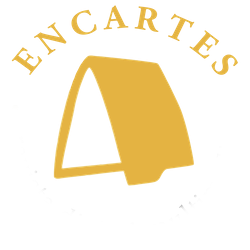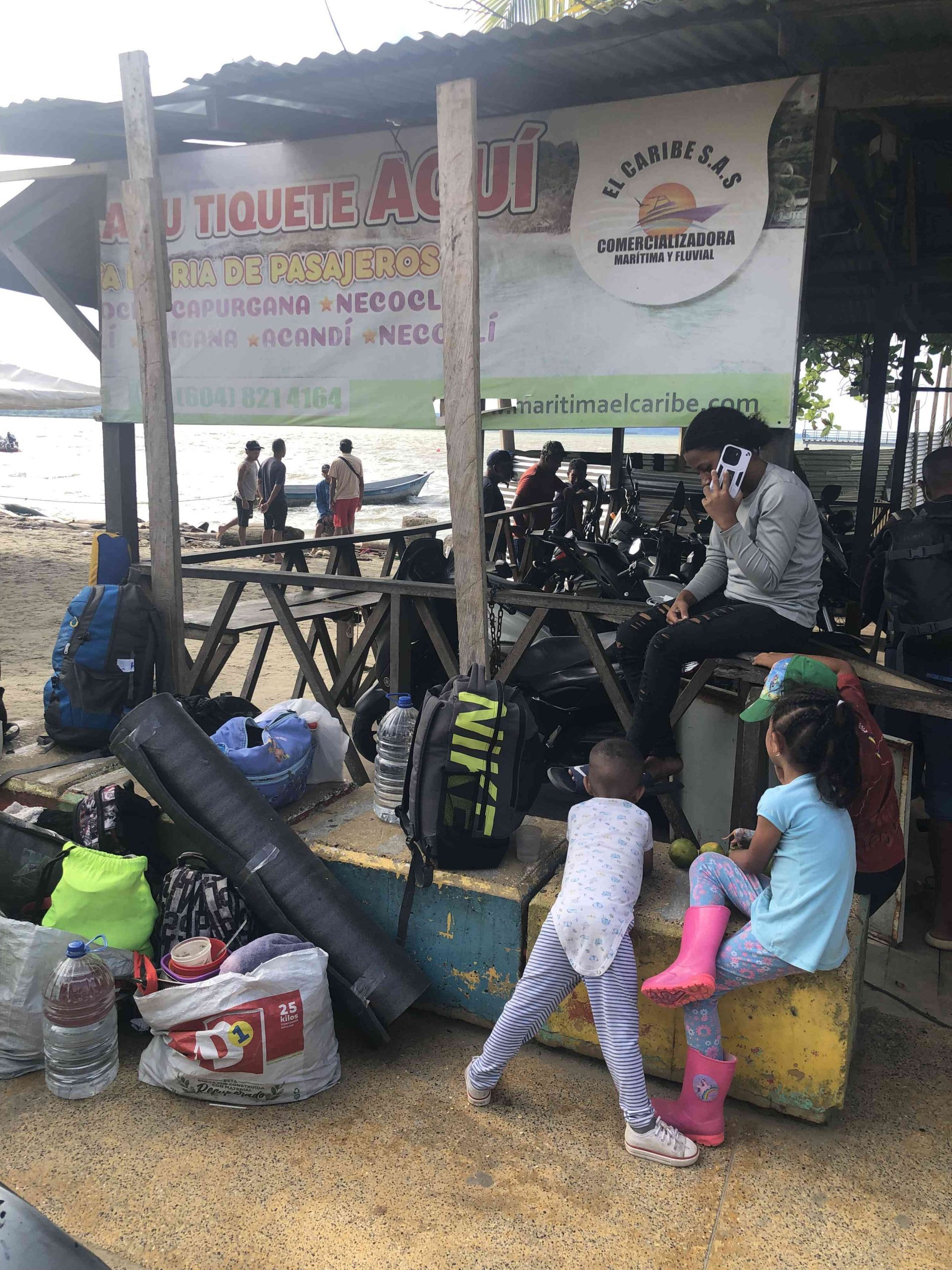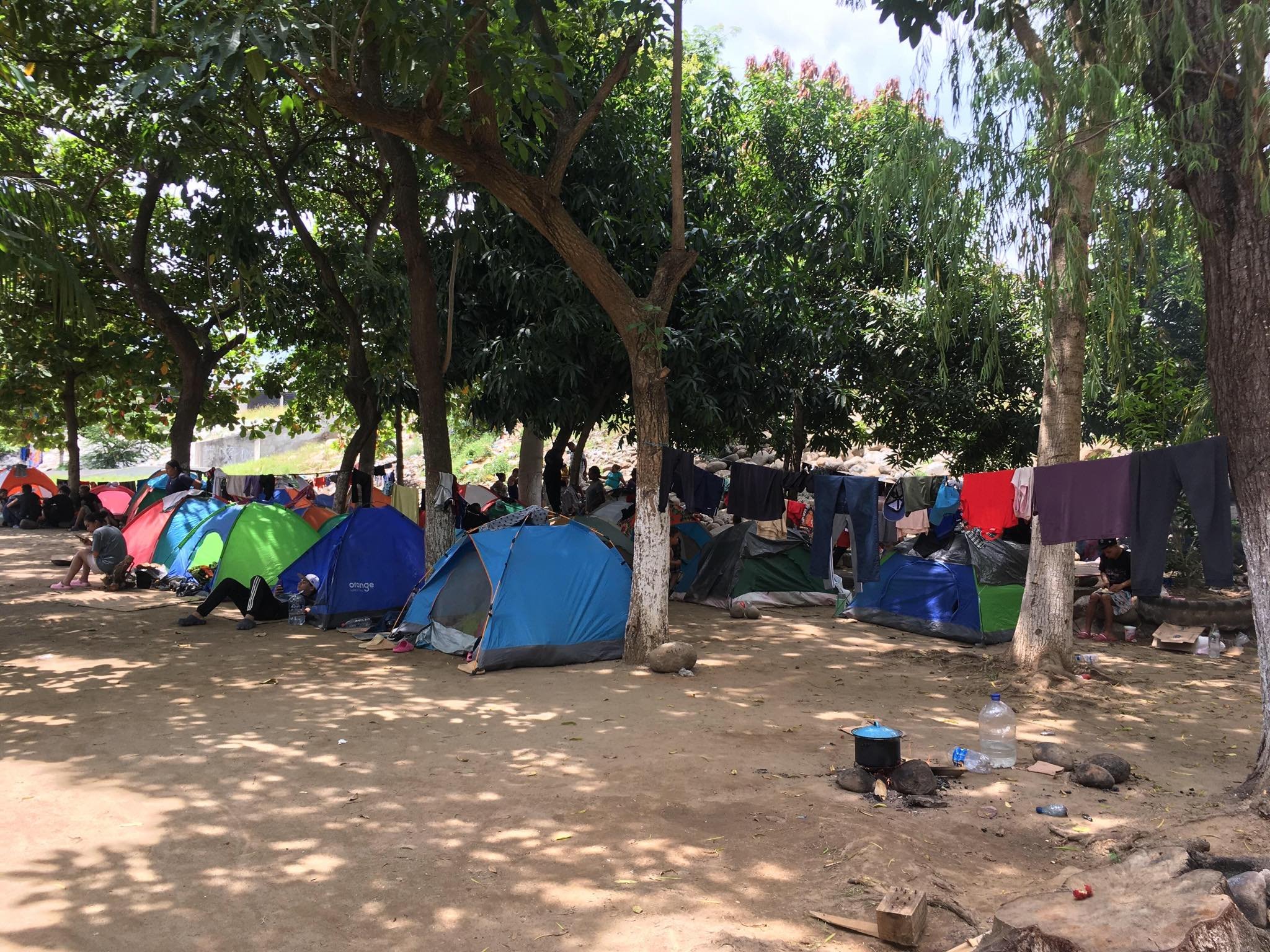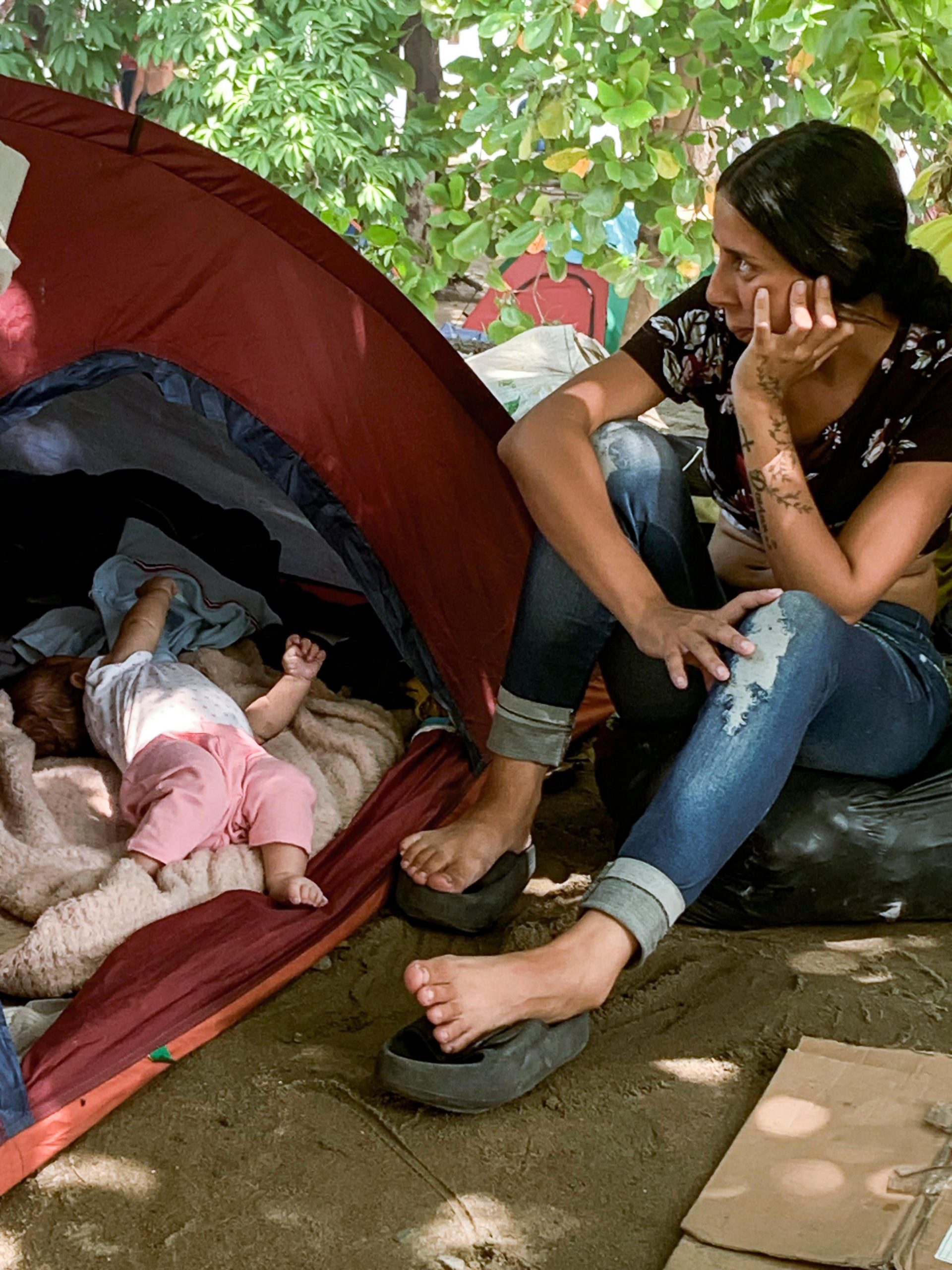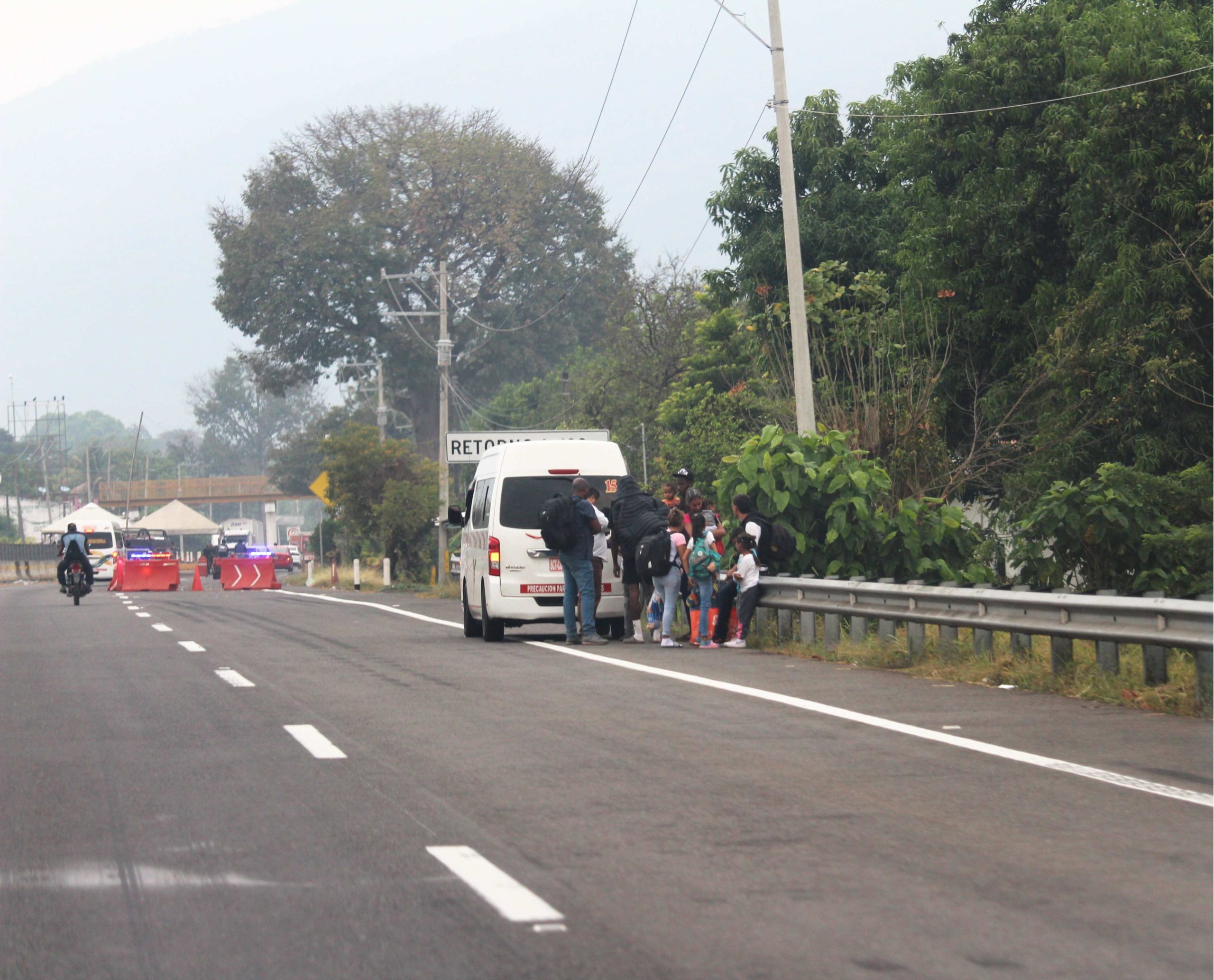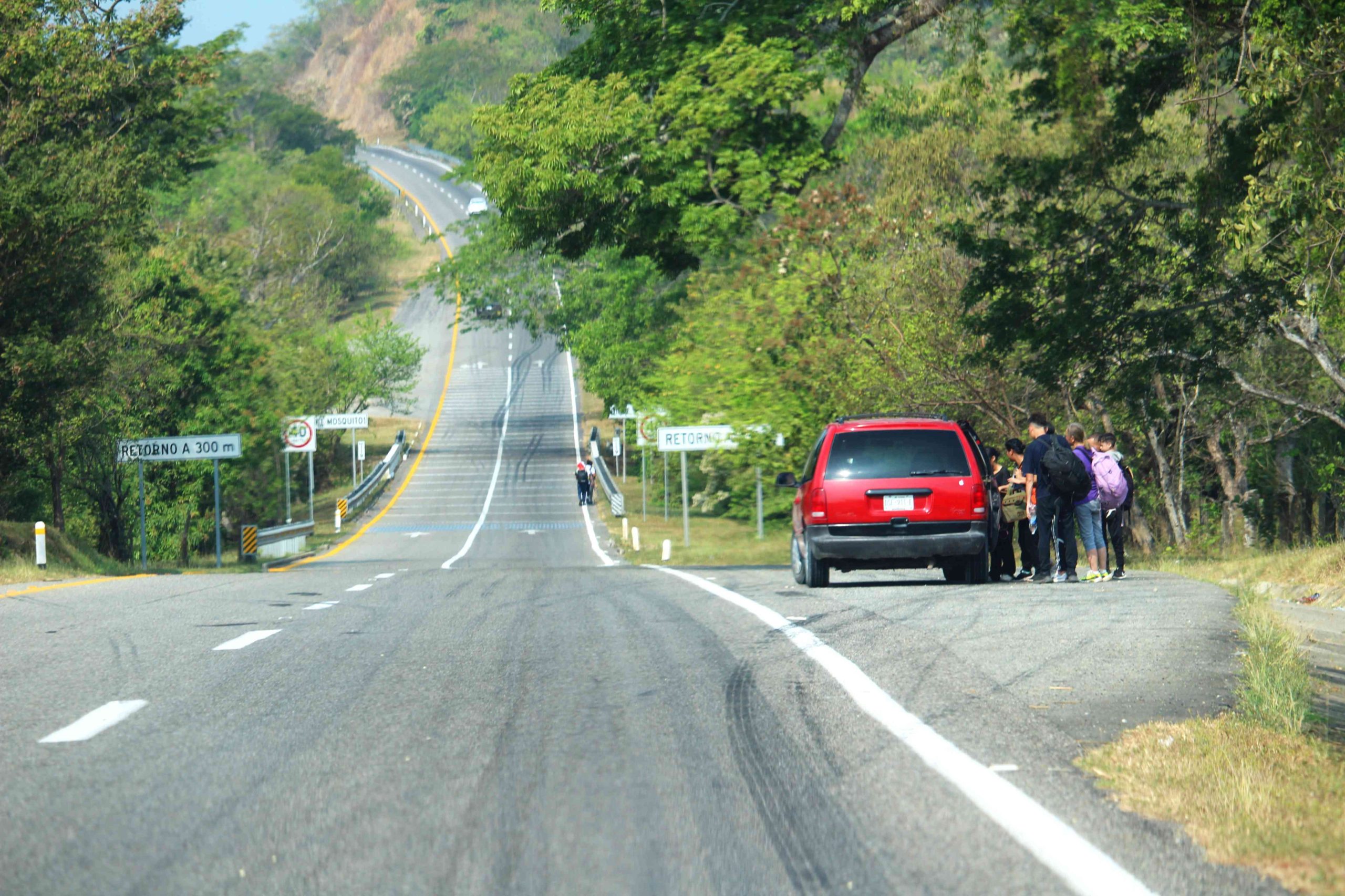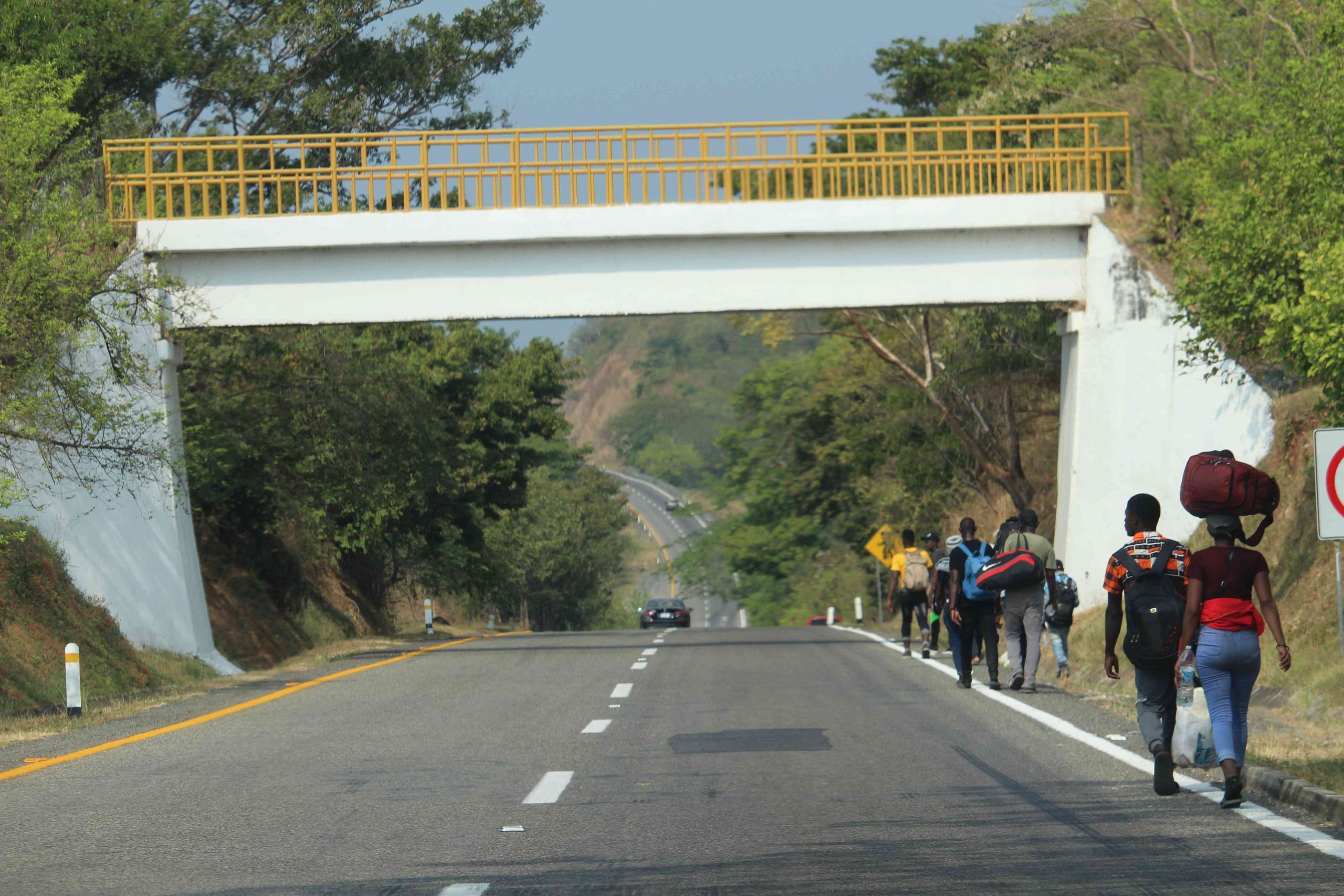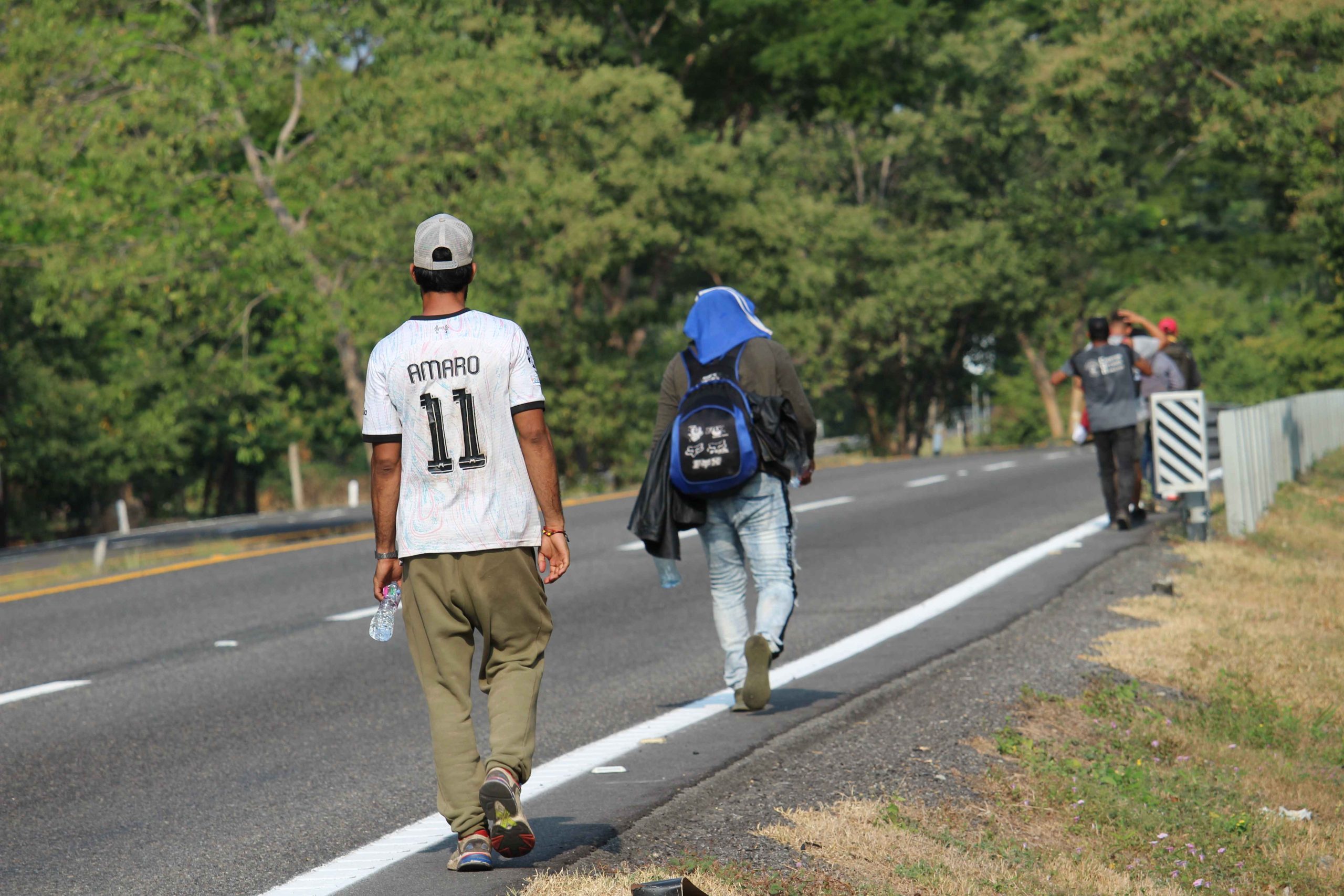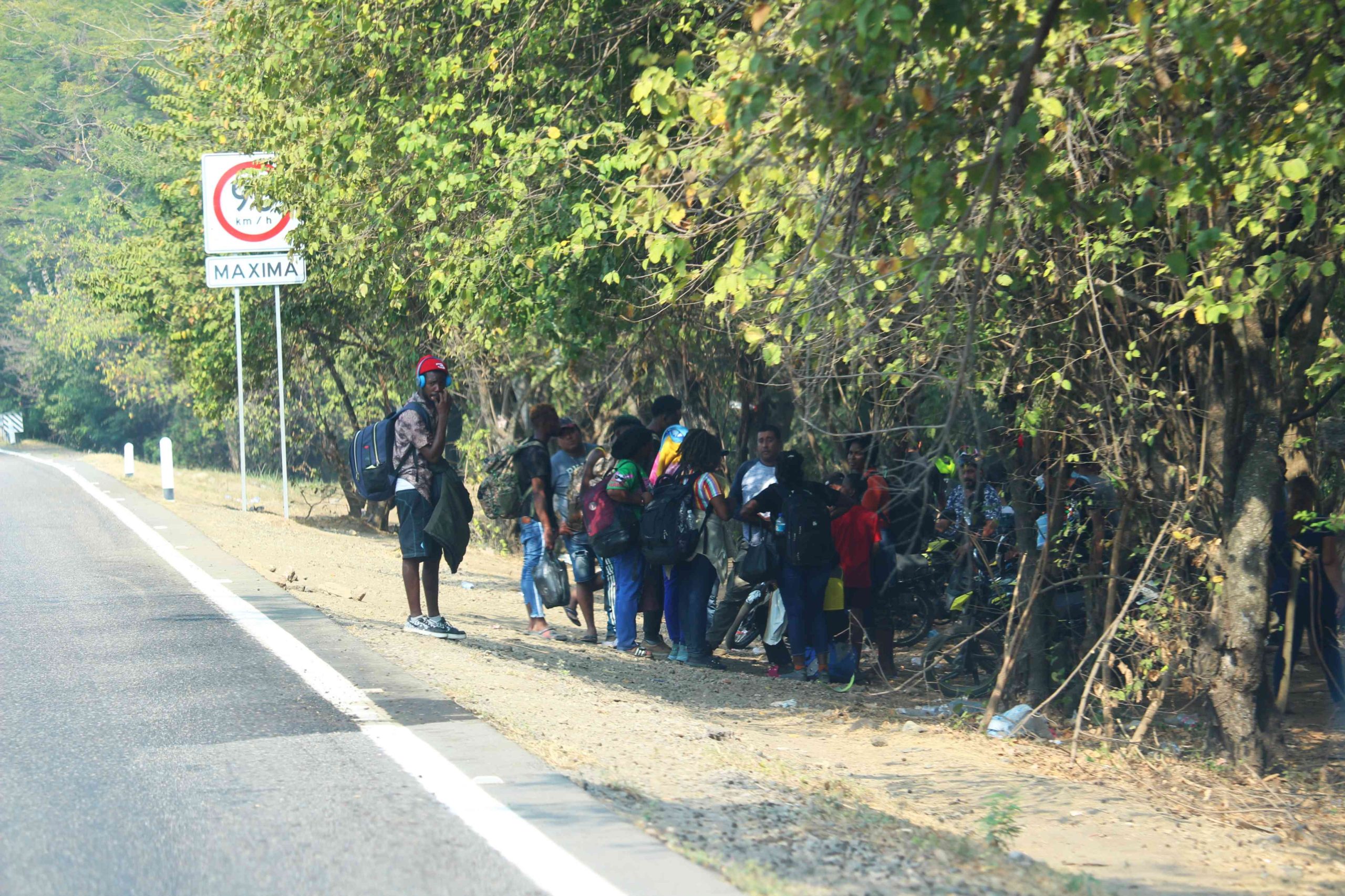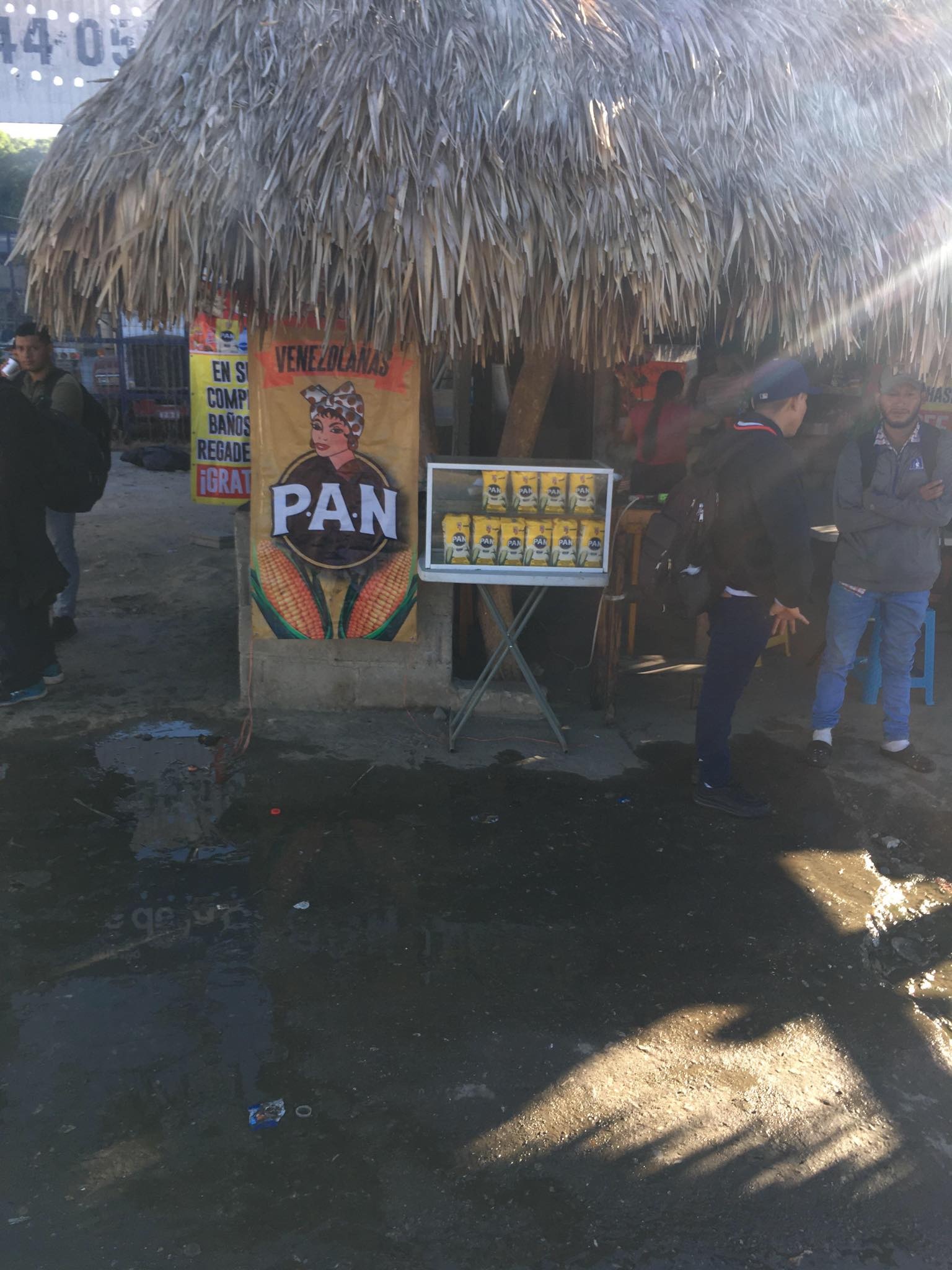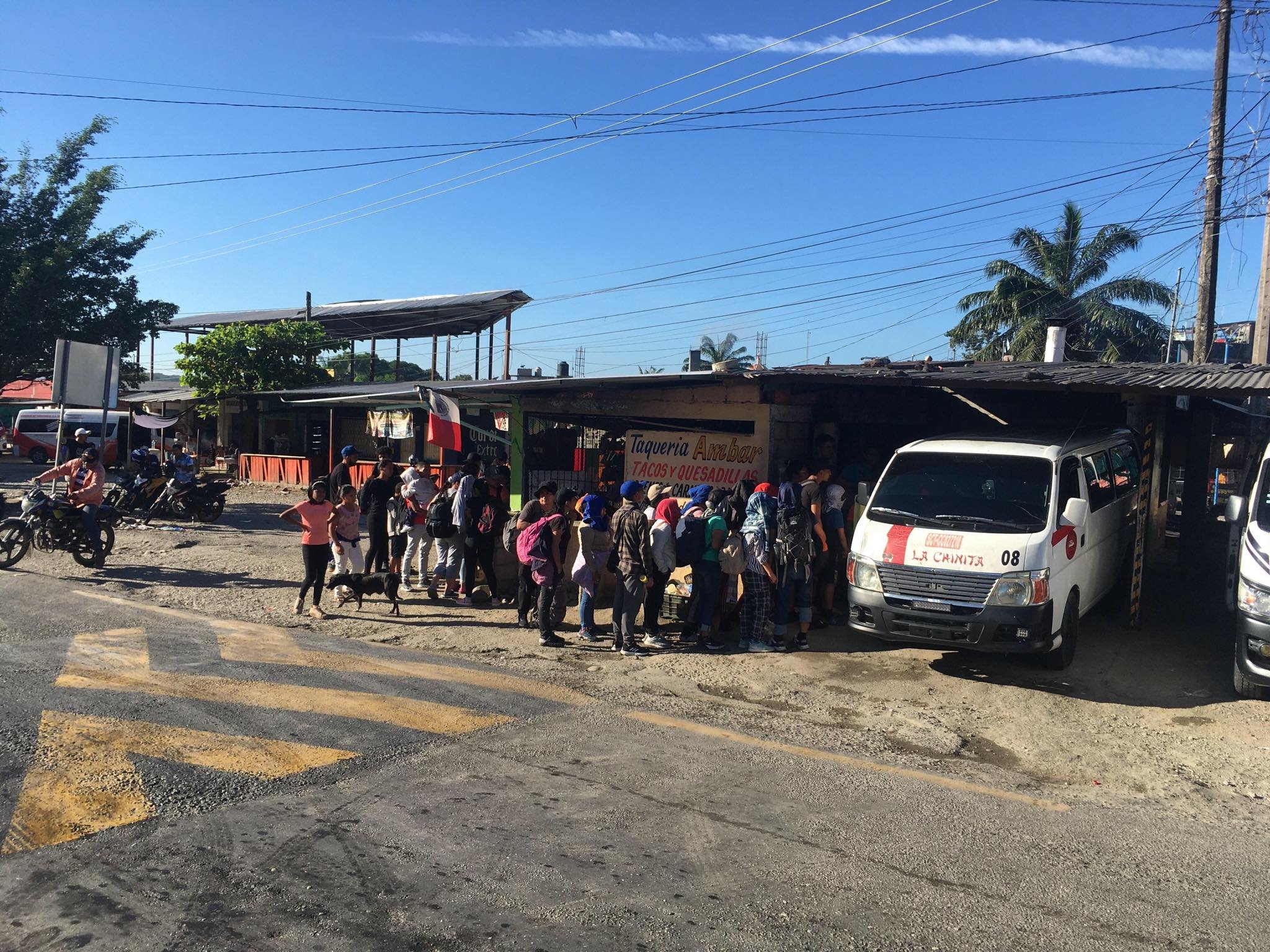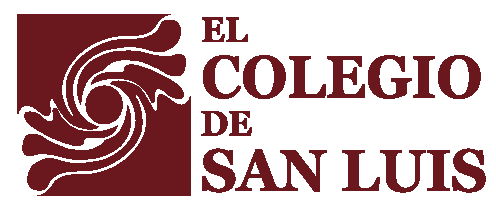Ethnography of the migrant route: the "walkers" of the coastal highway in Chiapas, Mexico.
- Abbdel Camargo Martínez
- Iván F. Porraz Gómez
- ― see biodata
Ethnography of the migrant route: the "walkers" of the coastal highway in Chiapas, Mexico.
Receipt: February 29, 2024
Acceptance: September 2, 2024
Abstract
The migration experience of people in the Soconusco region of Chiapas is heterogeneous. Some decide to wait in the city of Tapachula while they make their request for international protection and migratory regulation, others advance along the coastal highway under the inclement weather of the region, the sieges of the state police, the National Guard, agents of the National Institute of Migration (im), prosecutors' offices and non-state actors. The scenario is constantly changing. This article analyzes these "travelers", their forms of transit, the role of information and the experience accumulated in their journeys, which will serve as orienting axes for the "others". It also presents the migratory economy that emerges from the presence of these groups of migrants in the region. The text is based on the ethnographic record and interviews with "walkers" and local inhabitants, in a journey that goes from the Suchiate River to Arriaga, in the state of Chiapas, in staggered observations in the years from 2022 to the beginning of 2024.
Keywords: walkers, ethnography, southern border, transit migration, human mobility
an ethnography of the migrant route: the walkers on the coastal highway of chiapas, mexico
Every immigrant arriving to the Soconusco region of Chiapas, Mexico, has a different experience. While some decide to wait in the city of Tapachula while they file a petition for asylum or refugee status, others advance on foot down the coastal highway, where they face inclement weather and harassment by state police, National Guard, agents from the National Migration Institute, prosecutors, and non-state actors. The situation is constantly evolving. This article analyzes these walkersThe migration economy that has sprung up around these migrant routes through the region is another focus of the article. The migration economy that has sprung up around these migrant routes through the region is another focus of the article. The findings stem from ethnographic observation and interviews with the caminantes and local residents completed from 2022 to the beginning of 2024 in an area extending from the Suchiate River to Arriaga in the state of Chiapas.
Keywords: ethnography, migration in transit, caminantes, southern border of Mexico, human mobility.
Portico
Human mobility -it is often overlooked- requires for its functioning and dynamism the communication systems and transport infrastructure in the territories of displacement: whether on foot, by boat, railroad, air or any public or private transport, the communication infrastructure is in turn linked to the processes of population mobility. Although this relationship is obvious, it is not superfluous to analyze the mobility infrastructure that is deployed and implemented by population flows in specific territories, since the existing communication and infrastructure systems determine and condition the rhythms and times in which people carry out their migratory movements.
Due to its mediatization, the most recurrent image of the mobility of migrants in the world is based on the canoes and rafts used by people in the Mediterranean to try to reach the gates of mainland Europe, or the train journeys made by groups of Central Americans riding on the back of the train - the Beast - or more recently those collective mobility strategies in caravans in which people traveled on foot along the highways of southern and central Mexico, as well as the agglomerations of hundreds of people bathed in humidity and mud that crossed the Darien jungle on the border between Colombia and Panama. Walking, coming and going, waiting, advancing or retreating are part of migratory rhythms and patterns, and these are carried out on foot or on some means of transportation available in the places where individuals and groups are found. Their use will depend on multiple circumstances and contexts: economic solvency, national origin, density of the support network, information, migration policy and even climatic conditions. Thus, the means of transport may be used in a mixed way, alternating between walking and enabling the communication infrastructure that the context indicates.
The construction and habilitation of mobility infrastructure in the territories have the function of communicating and bringing together regions and the people who inhabit or surround them; they also guide commercial dynamics and establish links between regional markets and transnational and global commercial circuits. Thus, their function ranges from commercial exchange to social dynamics. Communication routes facilitate the systems of relationships that are being created in the territories and try to favor the connection between different points that are geographically distant. The laying of railways, roads or sea and air routes establishes ways of connecting regions, dynamizing economies and bringing populations closer together. Contemporary migratory routes are developed on these same systems.
East walk the world has been done mostly on foot or alternating means of transportation on specific routes. In this way, an experience of the territory lived and a memory of the know be at the various sites. How is this need to walk in transit territories established? Is it a strategy of the people or is it a mechanism forced by the migration governance in the countries? What experience and information is accumulated in this journey that alternates between walking and using the various means of mobility existing in the environment? What effect does people's walking have on the territories through which they walk? In contemporary human mobility - of continental scope - we are interested in highlighting the transmission of the experience of the journey with the effects that the circulation of people has on the territories in specific spatial and temporal processes.
Given that information and experience are fundamental for the development and consolidation of migratory processes, we take up the experience of the group of Venezuelans who have migrated to Colombia, who implemented walking on foot to carry out their migratory transit in that region. This same modality of displacement has been replicated in other stages of the journey and in other geographies, where information has been shared with other population contingents of very diverse nationalities and experiences; to this end, we present a series of ethnographic vignettes regarding the processes of population mobility carried out by undocumented contingents in the migratory corridor of the Soconusco region.1 We focus on this space to analyze the linkage of the experience of people in the recognition of the territory walked, who, on foot, establish the construction of routes, guide other people and, in that walk, energize local economies. We focus on this environment bordered to establish how the travel experience of the population contingents -in the first instance those of Venezuelan origin- derives in an accumulation of information that will serve other national groups -and in other territories- to continue the journey through the American migratory system.
The document begins by showing the experience of the "walkers" on the Colombian-Venezuelan border; we then analyze how this practice was implemented in the Chiapas-Guatemala border space by the Venezuelan and Honduran population along the Soconusco coastal highway, where other nationalities joined them; We continue with an approach to the local dynamics that were activated, among which border controls, the transmission of information among migrant communities and the local economy that was activated around this mobility on a temporary basis stand out. The article closes with some general conclusions.
Walkers on the Colombian-Venezuelan border
Venezuelan migration is one of the most important in Latin America today; according to data from the United Nations High Commissioner for Refugees (UNHCR), it is one of the largest in the region.acnur) and the International Organization for Migration (oim), until November 2022 more than 7.13 million people have left Venezuela and 80% of them are in different countries of Latin America: "in 2023 more than 8 million people will have left. The case of current Venezuelan migration represents the largest forced mobility in the history of the region" (Albornoz-Arias and Santafé-Rojas, 2022).
This panorama places us in the numerous stories, dreams and complexities of this population. One of them was the displacement by land from their places of origin to different parts of the territory, especially to the neighboring country of Colombia.2 (Albornoz-Arias, Santafé-Rojas, 2022). According to Lady Yunek Vargas León, this practice was referred to as "caminantes", "migrants and refugees who make their journey partially or entirely on foot. The term began to be used in 2018, when the phenomenon of Venezuelans walking within the country from their point of origin to the borders with Colombia was more visible" (2023: 68).
The so-called walkers in northern Santander,3 Colombia, as well as the so-called caravans in the south of Mexico, constituted a movement in which narratives, experiences and imaginaries were put into play, both of the people in transit and of those who watched with surprise as they passed through the territories. In this sense, Octavio, a member of the Ayuda en Acción team, an organization that supports Venezuelan migrants in transit, told us:
The so-called caminantes, which for some is derogatory in the region, began to gain strength in 2018. It should be remembered that at that time the Simon Bolivar bridge of these two countries was closed; many people were passing through the so-called trochas, which are those steps of misdirection, some are controlled by the guerrillas, some more by paramilitary groups and other groups. What we began to see is that the crisis in Venezuela worsened, many entire families, young people and children were entering, so some points of attention were created on the route for refugees and migrants, some shelters were set up to provide them with food, medical care and also information about the climate and the territory. The route is difficult to access because of the climate, because some kidnappings of migrants began or to take them to forced labor, there were many needs and that is why we also began to organize ourselves to provide support along this route; although there are not as many walkers as before, they are still present in this space (Personal communication, Los Patios, Colombia, January 2024).
Solidarity and xenophobia have been equally present with these populations. On the one hand, the attention of international organizations, non-governmental organizations, civil and religious associations was important to assist people; however, some media became strategic devices for the socialization of a collective imaginary of fear towards Venezuelan migrants in their confrontation with the local and border society, a picture that seems to be repeated in this and several other borders in the world. A local inhabitant of Cúcuta commented on this:
Now it is calmer here, there are Venezuelans, but not like between 2018 and 2021, that already seemed more people from Venezuela than from Cúcuta; I saw that insecurity increased more, prostitution, even their street commerce, they are well organized and then they are violent. We say that the Colombian threatens, but these people do kill you, but as in everything there are good and bad people, it was toche in those years (Personal communication, Cúcuta, Colombia, January 2024).
Another one commented:
The Venezuelan crisis has brought many people; before, Venezuelans used to come here to buy, to spend their money here, when the situation was better there, because they have always come to Cúcuta, but since Maduro's arrival the crisis is bad. That is why many people come here and many others go to Bogotá, Bucaramanga and other places. Sometimes they don't like Venezuelans very much in certain places, they are very conflictive, some say that Maduro took several criminals out of jail; imagine the population that comes, I think that is the one that goes up to Mexico and wants to go to the United States, because many have already gone there (Personal communication, Cúcuta, Colombia, January 2024).
Fear in society leads us to the search for culprits and producers of evil that is being built as a task of authorities and media, which is constrained by attacking the dangers of personal safety from the field of life policy operated and administered at the individual level (Bauman, 2013: 13).
Venezuelan women have also been sexualized and racialized from the local space. The bodies of migrant women in the receiving society have been sexualized and objectified because they are considered "territories without rights" (Téllez, 2023: 127). The practices and sensibilities of the majority of the migrant population in border cities, which are typical of experiences in movement, nucleated by fractures, discontinuities and relations of disjunction that define the global world as a world of flows (Appadurai, 1999), break the spatial and temporal regularities of the city. This is a corollary of global accumulation by dispossession (Harvey, 2005) and the strengthening of the neoliberal state that increased democratic disenchantment, generated multiple forms of violence and triggered migrations and forced displacements in the world. This situation has increased since the fight against terrorism in 2001 by the United States and the externalization of borders in various parts of the world, which led to the criminalization and racialization of migrants, refugees and displaced persons. It is mainly in the high-income countries of the global north that media and political discourses are updated, escalating in content and aggression and establishing governance for the global control of borders and populations.
In this environment, migrants and those in need of international protection began to articulate other territories and forms of displacement. The so-called caminantes and caminantes gradually began to open other crossings in Colombia and several South American countries (Peru, Chile, Argentina, Brazil, among others), but they also began to cross the so-called Darien Gap, to walk through Central America and to reach southern Mexico, especially during the pandemic and post-pandemic periods.4
Thus, with the implementation of more restrictive migration policies in the countries, the closing of borders and the induced crisis of the refugee system in the region, groups of migrants and asylum seekers implemented displacement strategies more in line with their reality. Faced with the lack of economic resources and the implementation of state control strategies that wore down the populations by extending documentation times, people began to walk the territories, to walk in groups, to surround the control spaces implemented and to generate a wealth of information, which was shared among the various groups. The experience is cumulative, although it must be adaptable to the particular context. Walking the Darien migratory route can be differentiated from the displacement carried out in Central American countries and southern Mexico in terms of risk and mobility options. Walking through the jungle involves greater risks than walking on asphalt or having the option of taking motorized transport.
The experiences of the Venezuelan walkers and those from other regions were recorded in various parts of Central America, but in the border area of Tapachula, in the coastal zone of the state of Chiapas, they became visible as they walked along the coastal highway of the Soconusco region. Small groups of Venezuelan and Honduran people organized themselves to march along the highway, which was joined by other populations of diverse national origins - Asians, Africans, people from the Caribbean - who began to walk in line on the asphalt, "skirting" the migration controls and articulating a movement of people moving on foot through different regions and countries.
The walkers on the Mexico-Guatemala border
The virus pandemic sars-CoV-2 defined a rhythm of displacement and restructured the migratory routes and flows through the continent through the establishment of what we call the Pandemic Government of Migration (Garrapa and Camargo, 2021). As a result, border control was tightened, with immediate closures and the implementation of containment and repression measures: the processes of migration regulation, the asylum system and the international protection system were cancelled or halted; the processes of detention and deportation of populations were increased; the systems for the protection of human rights and care for people in transit, such as shelters or solidarity organizations, were weakened. Also, intermediation networks via "coyotes" have increased their presence.5 The migration route to the United States or Canada, crossing the Darien jungle between Colombia and Panama, passing through Central America and arriving at the northern border of Mexico.
In Chiapas, the Soconusco area, as well as the Tenosique area in the state of Tabasco, are obligatory stops for migrants entering through the southern part of the country. This area has transportation systems and means of communication that facilitate the connection between Mexico and Central America, and is one of the most dynamic migratory routes in the world.
Between 2021 and 2022 Venezuelan migration became more present in Tapachula, according to figures from the Mexican Commission for Refugee Aid (Comisión Mexicana de Ayuda a Refugiados (eat) reported that they were among the first five nationalities to begin the refugee application process in that city. This population was having more presence in the public space: some were selling candy, others were cleaning car windshields in different parts of the city, while some were asking for money in Miguel Hidalgo Park and in Bicentenario Park in the center of the city. Many of them carried the flag of their country and on some of them wrote messages asking for help from the local population. A large majority of the Venezuelans did not have the resources to stay in the city or buy food, so some sought refuge in shelters, while others spent the night in some public spaces in the city center. At night they pitched their tents in parks and streets near the city center or were seen resting on cardboard under a roof or outside some commercial establishments.
This situation was very similar years before on the Colombian-Venezuelan border, "walkers need assistance mainly for food, transportation and lodging simultaneously, 100% of the walkers require help to be able to eat" (Mazuera-Arias, Albornoz-Arias and Morffe Peraza, 2022). Another situation that makes it difficult for many to initiate the process in the presence of eat was the lack of personal documents, as some indicated that they only had an identification card or a copy. The migratory status of most of the trekkers when crossing the border will be irregular, because 98% do not have passports (Mazuera-Arias, Albornoz-Arias and Morffe Peraza, 2022).
The first semester of 2022 saw a considerable increase in the presence of Venezuelans crossing the Suchiate River on the border between Mexico and Guatemala, in the coastal zone. While some advanced little by little towards the city of Tapachula, others decided to camp out and wait for the migratory authorities -based in that border municipality- to support them with more expeditious documentation or to be transferred to other spaces to continue their journey or with their migratory regulation process. The city of Tuxtla Gutiérrez -the state capital- was a space that was set up to move the population in order to "clear" the border city so that they could begin their migratory process elsewhere.
The waiting situation on the banks of the Suchiate River and in the city of Tapachula was overflowing the patience and waiting capacity of the populations. The implementation of a policy of attrition on the part of the authorities, due to the long waits that could take months to process migration procedures or refugee applications, prompted the populations, not only Venezuelan but also from other parts of the world, to implement other forms of mobility. Walking the territories was the option available to a large majority of Venezuelan and Central American migrants who did not have the economic resources to continue the journey or to hire an intermediary, so the strategy of walking in small groups along the roads of Soconusco gradually emerged. Juan, a migrant from Aragua, Venezuela, tells us about this:
I come with my family, my wife and I have four children; we are waiting to be transferred in some buses, that is what the Migration guard said, but we have been here for four days and nothing. It seems that they want money, because sometimes Haitians and other nationalities come and they take them first and leave us back here. You can see that there are several of us, there is a waiting list that we signed up, but nobody respects it, we don't know when they will move us from this place, we have no money, we go out begging in the streets to survive. The problem is the children because they don't always eat, the heat here is strong and the conditions are not good here, that's why I see that the kids are not always able to eat.6 that come alone are walking to move forward (Suchiate, Chiapas, April 2022).
The wear and tear and the bureaucracy in the paperwork of the applicants for refugee status of the population that was arriving at Suchiate was evident. The youngest groups of migrants decided to leave for Tapachula, where the families began to integrate, and were seen moving along the road to Ciudad Hidalgo, spending the night in Tapachula and continuing on to the municipality of Huixtla. An inhabitant commented:
On the highway we began to see many young people walking, at first they were stopped at the checkpoint that is by the bridge, leaving Ciudad Hidalgo, but later they did not say anything to them, they passed and passed in various groups. Some of them took the transport that goes to Tapachula, but there they were stopped by Migration at the checkpoints; it was clear that what they wanted was for them to walk, I could see that. The truth is that sometimes it hurts the soul to see the women advancing in that sun and with their suitcases and children, because the heat is really strong. I think it took about three or four hours to get to Tapachula, but the truth is that you could always see a lot of people on the road. At the beginning some of us gave them "raite", but when the caravans came they told us that it was better not to, because they could accuse us of being part of some "pollero" network. That is why many people did not give them rides (Personal communication, Jesús, inhabitant of Ciudad Hidalgo, May 2023).
In the coastal route of the Soconusco region, there are two main roads that connect with the roads to Guatemala, the southwestern zone, the mouth of the Suchiate River and its continuity on Mexican soil. The roads that continue into the two (official) border crossings that connect the Talismán-El Carmen border and the Tecún Umán-Ciudad Hidalgo border are linked by the Rodolfo Robles border bridges in Ciudad Hidalgo and El Carmen, respectively. In both cases, the customs system borders the Suchiate River. Here, the continuity of the highway meets the customs infrastructure that limits the flow of people, cars and goods, so the formal crossing is complemented by informal crossings where it is necessary to alternate means of transportation. Formal crossing can be done on foot, by bicycle, motorcycle, or motor vehicle. The crossing will depend on the regulations and documentation, so that undocumented population flows do not cross the border through these formal crossing points and, rather, follow the dynamics of the informal crossing points that "border", coexist and relate to the formal crossing points. In this case, in order to cross the banks of the border river, they alternate between walking and crossing the tributary by means of rafts or a zip line that allows them to cross over the border. The important thing, say the migrants, is not to lose the route and to keep moving forward.
Perhaps there are few certainties that migrants have when it comes to heading their way through migratory territories and, although they do not have so much information about the places, nor certainty about the trajectories, means of transportation or their costs, a sense of orientation is established based on the experience of other migrants who delineate routes, costs and forms of displacement. The "map is the others", state Rodrigo Parrini and Edith Flores (2018), to establish how migrants elaborate a series of mappings - written and oral - that are expressed in the experience of transiting territories and that serve as orientation systems for other contingents coming "behind". Migrant mapping establishes a nucleus of useful information for carrying out migrant displacement, reducing costs and increasing the possibilities of success. It is a strategy that reduces risk. As an example, in 2023 we found in a Facebook group the following written mapping that articulated the Cuban diaspora traveling along the Soconusco highway.
Migratory flows are always unpredictable, full of contingencies that cause them to be suspended, activated, accelerated or retracted. Sometimes they occur full of fervor and are highly visible due to their media impact, but most of the time they are rather discreet, sober and, due to their non-documentation quality, they try to remain anonymous in order to elude the state presence. Here, the information that serves as an orienting compass about the state of the road is vital, so that place, risks, costs and means of transportation are vital in the journey. So are the actors that facilitate or limit movement. Migratory circuits connect at least four actors that interact and interrelate in one way or another: migrants, state agents, brokers and local populations. This network is energized by the infrastructure established in the transit territories, but it also happens that, at contingent moments, other routes are explored and other roads are opened, generating new patterns on alternate routes. This is why the variables of time and place are vital in the constitution of contemporary migratory flows and patterns.
Routes, roads and controls for migratory transit through Soconusco
The so-called "walkers" make a reconnaissance of the territory and establish an experience-based relationship with it. In turn, this experience will become useful information for other people and groups that will walk the trails. This experience will serve to circumvent the various obstacles encountered, among them the network of control and administration of population flows by the State. The density of the forms of control of the migratory phenomenon in the continent has been increasing in recent years. In the state of Chiapas, fixed checkpoints have been joined by a network of semi-fixed and mobile checkpoints operated by various state actors such as the National Migration Institute (im), the National Guard (gn), border police and personnel from state and federal prosecutors' offices. In this movement through the territories, alternating between means of transportation and walking is part of the strategies implemented by the groups on the move to continue their journey and is a response to the dynamics of control and dissuasion faced by groups of migrants in the territories (see Map 1).
Border crossing: walking on the river
January is still the low water season in the region, so rivers and bends that flow into the Pacific Ocean are at their lowest levels. This has implications for border crossings. Every border can be transgressed and has a constantly changing character, hence its dynamic and flexible quality is exalted within its "nature". At this time it is feasible, for example, to cross the Suchiate River on foot. The rafts continue to operate, but in a different way, as the water landscape is altered with the creation of bends in the riverbed, where the water is channeled to specific places where the rafts can continue to travel, and drying up other parts whose level is so low that it is possible to do it on foot. This does not imply that the cost of the crossing does not necessarily have to be paid, but it is possible to make the crossing either by raft or on foot.
Once in Ciudad Hidalgo, there are three ways to continue on the road to the urban center of Tapachula: the first way involves taking the collective cabs that travel to the city, which requires taking breaks, because in the sections where the immigration checkpoints are located, it is necessary to get out of the vehicle beforehand and "go around" them on foot on dirt roads until reestablishing contact with the highway. The checkpoints located in Metapa and at the point known as El Manguito are fixed and must be skirted. Occasionally more mobile posts will appear along the road as a way of discouraging people from moving, which depletes the economic resources and the body's energy. Logistically, one or two collective units can be articulated so that the first one takes the passengers down, while the other one waits for a reasonable time while the people go around the checkpoint and, once the checkpoint is cleared, can take them up again and continue on to Tapachula. In this case, the payment and the advance is made in sections. This operation can be repeated according to the number of "active" checkpoints installed on the highway. A second way consists of following the instructions of the "guide", who can articulate and manage a series of people who use their private cars to transport the migrants along various roads. In this case, the price is higher than that of the collective cabs, but the migrants do not have to "go around" the checkpoints on foot, since the cars themselves take detours along country roads or through the various towns until they reach the city. A third way involves getting on the road and walking on foot. This route implies saving monetary resources; however, the wear and tear of the body due to the high temperatures experienced on the asphalt can have consequences for the health and energy economy of the body.
It should be noted that these three forms of transportation are not mutually exclusive and may even complement each other. Their use will depend on the resources available, the density and presence of governmental bodies along the routes or the arrangements made with the intermediary actors along the way. Once in Tapachula, there will be a period of rest to regain strength, obtain more information and articulate the support and intermediation network that will make it possible to continue on the road.
Walking and "skirting" checkpoints
Soconusco is characterized by a tropical environment with high temperatures. Here, having a travel strategy is important to ensure that the body's economy does not suffer excessive wear and tear. For this reason it is important to start walking when the sun is not yet up and the sun has not yet risen. When leaving Tapachula, the immigration checkpoint is located on the bridge known as Viva Mexico. This post was for a long time a space of control and containment of the migratory flows that, being inside the city, it was feasible to have different buses that were filled with people that were channeled to the Migratory Station Siglo xxi within the same city.
Since 2023, we have detected that a series of mobile or semi-fixed posts have gradually been installed along the coastal highway to dissuade - but not stop - the formation of large groups advancing along the roads. In this way, a policy is established to wear down the physical and economic energy of the people, who, as their fatigue and accumulated illnesses sap their will, and it is hoped that they will give up their attempt to continue on the road.
In fact, small groups of family or national groups are observed, as well as contingents that, based on trust and accompaniment along the way, are articulated in the territories. They are seen walking in line, with only a few belongings that they will have to carry or drag and taking breaks and rests under the shade of the trees or on a roof of the villages through which they pass.
In January 2024, the alternation between walking and using some form of motorized transport was maintained. Therefore, the transfer by stretches -on foot and by motorcycle- was still active. The cost of this transfer varied, but on average 200 pesos per person were charged for a trip of just a few kilometers. It should be noted that at that time the presence of the African contingent was the most visible flow and they were the ones who were mostly making use of this form of mobilization, although the groups of "walkers" were made up of mixed nationalities. Articulated with the same purpose - to continue the migratory route to the north - information on the obstacles along the way, where to rest, eat or use toilets, was distributed in various social networks or exchanged orally. As an extremely valuable resource, this information was translated into the various languages that the groups and nationalities mastered.
Some local inhabitants saw the possibility of making short trips on their own motorcycles and charged people for "advancing" them in staggered stretches, always limited by the spaces of state control. To this end, some locals even bought more motorcycles as a migrant economy was triggered that stimulated local incomes.
We would like to emphasize that what characterized this moment of the migratory journey was the use of secondary and local roads to continue the journey. Walking through "the bush" - as the people mentioned - was the strategy implemented by the people, who, due to the intimidation they suffered from state agents, were forced to use alternative routes, which, due to their clandestinity, increased the risk and vulnerability of the travelers.
We could feel this practice throughout the observation visit, since the groups resting under the shadows of the trees were pressured by National Guard agents to continue walking: "Move forward, move forward, you can't be here," they frantically told them. So what characterized this time was alternating between the use of secondary roads and the Pan-American highway, as well as the exacerbation of the feeling of harassment by the state agents, who did not stop them or ask for documentation, but only intimidated them, forcing them to keep walking in order to push their fatigue to the limit and force them to conclude their migratory project.
In this journey, relationships are recreated, bonds and complicities are strengthened, but tensions are also created, not only among the people on the move, but also with those with whom they interact along the way. Migratory spaces are also relational spaces for the exchange of ways of knowing and experiencing the world. What happens in these transitory interrelationships between travelers and local populations? What effects does their presence have and what fields of daily life can be linked? Here we present some elements oriented to the economic aspect.
Migrant economy on the coastal route
The migrant economy on the Soconusco highway was gradually built around the transit of migrant subjects. We identified the need for "guides" to move through the various countries and their roads and all the economy that is deployed for that purpose; there also appear elements of daily life that require a level of relationship and basic exchange to be carried out. Walking becomes an escape, but the effects of externalizing borders are also experienced.
In this sense, the securitization The externalization of asylum, which is emerging as a new tactic and "weapon" in the construction of a vertical hemispheric border, is not a minor issue. This leads many migrants to resort to the so-called "coyotes" to lessen the risk or any eventuality along the way. The guides along the migratory route are not something new, but the ways of crossing the Central American space and the south of Mexico by sections are, since they know where to pass or where a police or military checkpoint may be. These people are the ones who have face-to-face contact with the migrants, sometimes they are part of a network, others are subcontracted, although they are also the first people who can be detained and punished by the authorities, without reaching the "coyotes", who are located through social networks, cell phone calls or messages. These services have grown as a result of the massive movement of migrants through Central America and southern Mexico. Their figure is controversial, sometimes they are considered necessary to advance in the journey, for others they have the stigma of being the villains in human mobility (Porraz, 2023: 3).
Beyond the so-called "coyotes" and the big business that was deliberately growing, there was also the sale of food and the use of local transportation that was in demand on the Huixtla-Arriaga route, in addition to the motorcyclists that could be seen on some points of the highway. A lady selling water and soft drinks in Pijijiapan told us:
There are a lot of migrants walking along this road now, I started selling water, soft drinks and pens because it was the most consumed with so much heat. We saw that in the stores in some towns they would go in and take a lot of water, cookies and soft drinks, some sell food, but it is not always sold, because they do not always eat the food that we make. The migrants have other ways of feeding themselves, which is not the same as the Mexican way; now everyone is "making a killing" as we say here, because, you see, the transportation companies can't keep up, even some private cars come and load people and leave them before the immigration checkpoints or the military there arriving to Tonalá. There are also those of the motorcycles, there are several at many points, but some are already abusing, overcharging and sometimes in dollars, says an acquaintance, but that is already a lot. It is not fair to be abusive with these people (Personal communication, Escuintla, Chiapas, November 2023).
Another resident of the municipality commented:
Now there are many people passing through here in Escuintla, you can see that many of them are migrants, and they are buying their things to walk, because, as you can see, not all of them bring their money, they are walking, but it is hard, the heat is very strong, we see them passing with children and their big suitcases. You see, there by the Oxxo, in those little stores there are women who say they offer Venezuelan empanadas, and they buy them because they look like what they eat in their countries; look at their sign there. Rotisserie chicken is also selling a lot, several take their chicken or bread for the road. But there are many of them passing through here (Personal communication, Escuintla, Chiapas, December 2023).
People living near the road began to go out to sell their products and, as mentioned above, some farmers from the region went out with their motorcycles to work in transporting the walkers, since the business was in demand and there was more money to be made there than going as a day laborer to the fields. By the end of December 2023, the number of migrants was decreasing and so were the number of people setting up businesses along the route. Migratory control seemed to be decreasing, but there were other factors that explained this: the lack of officials from the National Migration Institute (Instituto Nacional de Migración (im), who had little budget and the beginning of the electoral season in both Mexico and the United States. The presence of the migrants in the so-called "local migrant economy" is contradictory among the population of Soconusco, because while one sector rejected the presence of these people, others pointed out that with the arrival of migrants, particularly those of Cuban and African origin, they had seen their income improve due to the different services offered: motorists, those who offered food, sale of cell phone chips, memory cards or simply those who charged for charging the batteries of mobile devices. The migrant economy along the Soconusco highway reflects the imprint of the positive effects of the presence of people in the localities through which they travel.
Thinking about the transit of "walkers" in Soconusco
This work shows the importance of documenting the transit of the "caminantes", as sharper ethnographic descriptions of this emerging and seemingly increasingly Mexico-centered hemispheric vertical border are needed (Kovic and Kelly, 2017).
In our views of these transits through the Soconusco, we discuss two questions: first, the meaning of the collective experience of human mobility, the memory that is constructed of the border spaces, "of the gap", "of the line" and of the migrant subjects who walk the territories; second, on the temporality and the processes that occur in the places of transit and the impact of these people on local dynamics. It seems important to us to recover the images and narratives of these "walkers" that we observed in the Soconusco region of Chiapas. Who cares about their lives and their journeys? A question that makes us turn to the debate on the population of the global South and its productive and/or "parasitic" human potential for capital, which restructures its accumulation patterns -by "dispossession"- as David Harvey refers; but also the State, as the institution responsible for guaranteeing the fundamental rights of its society, experiences processes of political delegitimization and loses sovereignty by sharing parcels of power with capital and organized crime, becoming an institution incapable of governing under the formal underpinnings of a Democratic Constitutional State (García, 2019).
The transit of the "walkers" along the coastal highway of Chiapas reawakened feelings of solidarity and xenophobia that arose from the so-called "migrant caravans" in the winter of 2018, while activating a migrant economy of that human mobility on the part of the local inhabitants of the region. It is important to observe people selling water, soft drinks, cigarettes and other supplies for the road, besieged by the relentless heat, and link them with the series of intermediaries that were improvised, such as motorists who did not speak the same language, so the signs and the Google translator served to close the deal.
Gastronomy was again presented as a mediation to know and recognize those others who arrive, as suddenly appeared the sale of Venezuelan empanadas that, in reality, were improvised or were more similar to those consumed in the region, the sale of bread flour to make arepas, learning and selling "tinticos" without sugar and with cinnamon; all of this will be part of the collective migrant and regional memory, which also made the local people remember their own, the departure of their children and relatives to the United States a few months or years ago.
On the other hand, these practices of the "walkers" had from the State institutions a connotation of violence accentuated in the idea of a police State, although they were not regularly detained, the pressures and extortions on them did increase; on numerous occasions we witnessed extortions by the state police, agents of the police, the police and the police. imThe police, agents of the Chiapas state prosecutor's office and other corporations; with the argument of their irregular condition, they took people off public transportation, asked them for money to continue their trip or simply to make them walk and wear out their meager economies -even their bodies- in their journey under the incessant heat.
Venezuelans and Central Americans began the route of the "walkers" on the coastal highway, then Cubans, Africans and some Asians joined them; there are also economic, cultural and support network differences between nationalities. On the way, differences and small signs of solidarity were shown. We saw some families walking together, women supported each other, they lent each other their carts to transport the children; but also the social networks served to draw an emerging map, to know the routes, transportation costs and even to locate which immigration and/or police checkpoint was extorting more or less. Several domestic animals such as dogs accompanied the transit, music on speakers or headphones were also present to support the trip.
The observation made and the interviews conducted with this population led us to reflect that ethnography cannot be reduced only to a local level, that learning from the "walkers" who are in constant movement implies knowing their maps, their responses and possibilities of action. In this sense, José Manuel Valenzuela (2009) invites us to think of a "bioresistance" or a "minor biopolitics", in terms of Giorgio Agamben, in which locating these realities from the asphalt led us to trace the circulation of contexts, to propose logics of relationships, to look at and compare with other borders, while translations and associations are needed between these sites of mobility and the territories through which they pass.
Finally, it should be mentioned that this practice of the "walkers" through the Soconusco has been gradually diminishing; however, in the hours in which we close this text new forms of collective mobilization are activated to confront state control and the so-called criminal governance that haunts the life time of the entire border region, with impacts that we can already begin to register. However, the memory of this cross-border transit, where experiences of help and rejection alike are kept, draws in the uncertainty of people -migrants and non-migrants- a fragile experience of the shelter provided by the canopy of the many ceibas that abound in the region, in whose shade rest, reverie and hope are provided.
Bibliography
acnur (2020). Situación en Venezuela. Informe del Alto Comisionado de la Organización de las Naciones Unidas para los Refugiados. https://www.acnur.org/situacion-en-venezuela.html
Appadurai, Arjun (1999). Modernity at Large: Cultural Dimensions of Globalization. Minneapolis: University of Minnessota Press.
Bauman, Zigmunt (2013). Miedo líquido. La sociedad contemporánea y sus temores. México: Paidós.
Garrapa, Ana Mary y Abbdel Camargo Martínez (2021). “Gobierno pandémico de las fronteras y las movilidades. Realidades comparadas a nivel internacional”, (Trans)Fronteriza. Boletín del Grupo de Trabajo Fronteras: Movilidades, Identidades y Comercios. Buenos Aires: clacso. Disponible en: https://www.clacso.org/boletin-11-transfronteriza/
García, María del Carmen (2019). Violencia y globalización. Reflexiones marginales desde el sur de México y Centroamérica. México: conacyt/unicach/Juan Pablos.
Harvey, David (2005). Espacios de esperanza. Madrid: Akal.
Kovic, Christine y Patty Kelly (2017). “Migrant Bodies as Targets of Security Policies: Central Americans Crossing Mexico’s Vertical Border”, Dialectical Anthropology, 41(1), pp. 1-11.
Mazuera-Arias, Rina, Carmen Vivas-Franco, Jesús Gerardo Díaz y Neida Albornoz-Arias (2022). Informe de movilidad humana venezolana vii. Caminantes en retorno: trabajo y ocupación (1º de agosto al 30 de septiembre 2022). San Cristóbal: Observatorio de Investigaciones Sociales en Frontera (odisef).
Morffe Pereza, Miguel Ángel (2022). “Desencuentros y conflictos en la dinámica de la frontera colombo-venezolana”, Aldea Mundo. Revista sobre Fronteras e Integración Regional, año 27, núm. 53.
Parrini Roses, Rodrigo y Edith Flores Pérez (2018). “El mapa son los otros: narrativas de viaje de migrantes centroamericanos en la frontera sur de México”, Íconos. Revista de Ciencias Sociales, 61, pp. 71-90.
Porraz Gómez, Iván Francisco (2023). “Las y los guías en el espacio de tránsito Centroamericano: entre el apoyo y el estigma, Chiapas Paralelo. San Cristóbal de las Casas: El Colegio de la Frontera Sur/conahcyt.
Rojas, Martha Luz y Hugo Ángeles (2023). Diagnóstico de la dinámica económica, social y demográfica, con énfasis en la movilidad humana en la región del Soconusco, Chiapas, México, y en los municipios estrictamente fronterizos. Ciudad de México: cepal.
Téllez Cáceres, Magda Viviana (2023). “Configuraciones culturales producidas a través de la experiencia de movilidad forzada de mujeres jóvenes en dos territorios transfronterizos latinoamericanos”. Tesis de maestría en Ciencias en Recursos Naturales y Desarrollo Rural. San Cristóbal de las Casas: El Colegio de la Frontera Sur.
Valenzuela Arce, José Manuel (2009). El futuro ya fue, socio-antropología de los jóvenes en la modernidad. México: colef/Casa Juan Pablos.
Vargas León, Lady Yunek (2023). “Migración venezolana: los ‘caminantes’ hacia el sur de América Latina”, Revista Cuadernos do ceom, Chapecó (sc), 36 (58), pp. 59-74.
Abbdel Camargo Martínez D. in Anthropology from the Universidad Nacional Autónoma de México. Researcher for Mexico of the Secretariat of Science, Humanities, Technology and Innovation (secihti) commissioned to El Colegio de la Frontera Sur (ecosur), Tapachula unit, in the Academic Group of Migration Studies and Transborder Processes of the Department of Society and Culture.
Iván F. Porraz Gómez holds a PhD in Social and Humanistic Sciences from the cesmeca-unicach. Researcher at El Colegio de la Frontera Sur (ecosur), Tapachula unit, in the Academic Group of Migration Studies and Transborder Processes of the Department of Society and Culture.
